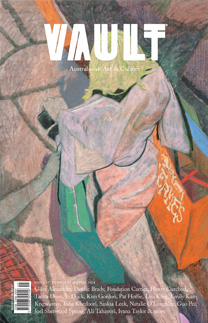Daniel Boyd
Paradise Lost
Daniel Boyd’s paintings make manifest an erased history.
Simple interwoven patterns mark two of the paintings from Daniel Boyd’s 2013 series New Hebrides. They are stark and unadorned and beautiful in their unfussy way. The only real sense of detail beyond the motifs is in Boyd’s erasure of it – his now well-known treatment of the canvas, in which he affixes a sea of pointillist glue dots, or “lenses” as he puts it, to the surface and blackens all that remains. Though similar in their looping, interlocked curves, the two patterns are tellingly different; they are part of the same semiotic code, but they speak of distinct things.
The paintings depict sand drawings from Pentecost Island, Vanuatu, the homeland of Boyd’s great grandfather. The 31-year-old cannot decipher their visual language on his own. The information is not something he has been privy to, but rather something he has lost.
As we sit in Boyd’s studio – a 19th century sandstone shed that adjoins his home, high up on a hill in Marrickville – he laughs, quietly, wryly, at his means of decoding. “It was via Google,” he says. “It’s a sand drawing that everyone on Pentecost Island has to know how to do before they can pass to the afterlife – like their passage to the afterlife or to paradise.
“I could have not painted the work and waited until I learnt that design in a legitimate way. But I really wanted to show people that design and I wanted people to know that it came from Flickr or whatever – some anthropologist’s photograph – and that it might be some kind of... Subscribe to read this article in full

























